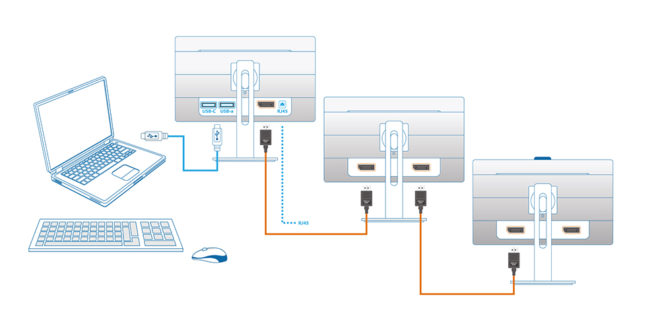If you have recently bought a new smartphone, tablet, laptop or desktop computer in the last few years, chances are they came with a USB Type-C port, the latest revision of the USB ports. But what is it actually capable of? Let’s find out…
How did USB-C come about?
USB Type-A is the ubiquitous 4-pin, flat port/plug variant of USB that we have all become familiar with for over two decades, supported from the first USB 1.0 spec. It allowed a standardised connection port and plug for a variety of peripheral devices, from input devices to printers and to novelty USB-powered devices, too.
The newer USB 3.0 (2011) and higher (USB 3.1, 2013, and USB 3.2, 2017, standards revised the common USB Type-A port and added five more pins to reach SuperSpeed, which achieves over 10x faster data transfer speeds with 5Gbit/s (625 MB/s) versus USB 2.0’s 480Mbit/s (80 MB/s). This has been doubled and quadrupled with USB 3.1 and USB 3.2 (1.25 GB/s and 2.5 GB/s for SuperSpeed+). 2014 is the time when we meet the USB Type-C, which uses a reversible plug – a first in USB’s history – ending the confusion about which orientation of the cable is the right one.
What is the USB Type-C capable of, besides high speed data transfer?
USB Type-C, thanks to its 24-pin configuration, supports the following technologies:
– USB Power Delivery 2.0: Using USB’s Power Delivery specifications, devices are able to draw up to 100W power (20 V / 5 A) through the USB-C cable, which enables charging and powering smartphones, tablets and even high-powered devices such as laptops. Since the Power Delivery is transparent to any data transmission mode, it can be used with any of them.
– USB Alternate Mode: Alternate Mode is an optional feature of USB-C, which is up to the vendors to support. It uses the additional
pins of USB-C to negotiate and transfer video signals via a single USB-C cable while still enabling data transfer. The DisplayPort Alt (Alternate) Mode is the most popular and most supported one, but MHL Alt Mode, Thunderbolt Alt Mode, HDMI Alt Mode and VirtualLink (for VR headsets) Alt Modes do also exist.
It is important to note that a device that implements USB-C does not necessarily implement USB 3.1 or 3.2, USB Power Delivery or USB Alternate Modes. It simply describes the receptacle and the plug, and since the USB Type-C ports are also backwards compatible with legacy USB specifications, there are also USB Type-C cables available where one end only supports USB 2.0, therefore proper identification of the USB generation and supported protocols of the host and connected devices is a must.
How can you achieve a multi-monitor setup and docking station with USB Type-C?
With features such as Power Delivery and Alternate Mode, the supported USB Type-C ports are a blessing for mobile devices (tablets, laptops etc.), since they require less, or even just one port for pretty much everything, power, display, peripherals, even Ethernet! Prior to USB Type-C, connecting a laptop to external monitors and peripheral devices looked like this:
It’s a mess of cables, taking valuable desk space, drawing all the power from the laptop. It looks unsafe, distracting and is simply not the optimal solution. While there are separate USB Type-C docking stations available, they still take up valuable desk space and do not exactly solve cable management, either (not to mention the additional cost).
Now, Philips’ USB-C docking monitors come into play here. The 241B7QUPBEB, an elegant, ergonomic and three-sides frameless 24” business IPS monitor in Full HD comes with a built-in USB-C docking station with 2x USB-C 3.1 Gen 1 and 2x USB 3.0 (Type-A) ports, a RJ-45 port (supporting up to Gigabit Ethernet), in addition to video inputs VGA, DisplayPort 1.2 and HDMI 1.4 and a DisplayPort output for daisy-chaining multiple monitors.
The included USB Type-C ports can use DisplayPort Alternate Mode to transfer the video signal and extend the laptop display, while the Power Delivery with 60W power output can charge/power laptops easily with the same cable.
Keyboard and mouse can be connected to the USB 3.0 Type-A ports on the monitor, and thanks to the RJ-45 port, the monitor enables Ethernet connection to the laptop via USB-C, too. By using a hardwired connection as opposed to Wi-Fi, a faster, more stable and secure connection can be achieved.
What is more, a three-monitor setup is also possible as seen above (main image), thanks to daisy-chaining multiple monitors with DisplayPort input and outputs on several Philips monitors, such as the 241B7QPTEB with a DisplayPort loop in the middle and the 241B7QPJKEB on the right, the latter equipped with a built-in Windows Hello webcam that can be popped up or down for increased security.
Can I achieve a portable monitor setup with USB Type-C, too?
The former example demonstrated a full productivity focused desk setup with three monitors, using full advantages of the latest USB Type-C features.
What if one needs a multi-monitor setup on the go?
The display specialist AOC has just the right product for this occasion – the AOC I1601FWUX is a 15.6” (39.6 cm) Full HD portable display with USB-C connectivity. It is equipped with an IPS panel, 5ms response time, and both the power and the display signal are transferred with just a single USB Type-C cable – using Power Delivery and DisplayPort Alt Mode.
The portable I1601FWUX is included with smart cover that folds to support the display both in horizontal and vertical orientations and offers different tilt options, and the included software allows the display to adjust its orientation automatically. Now, thanks to the simple USB-C connectivity users can enjoy multi-monitor setups and the increased productivity it creates even in mobile situations such as on the train, on a plane or simply wherever you are!
Please check your laptops’ or other devices’ manual and website to ensure that it supports USB Type-C Alternate Mode. The following symbol will be found in addition to USB SuperSpeed symbols on the ports which support DP Alt Mode:
This article is partner content from AOC.
 PCR Tech and IT retail, distribution and vendor news
PCR Tech and IT retail, distribution and vendor news




